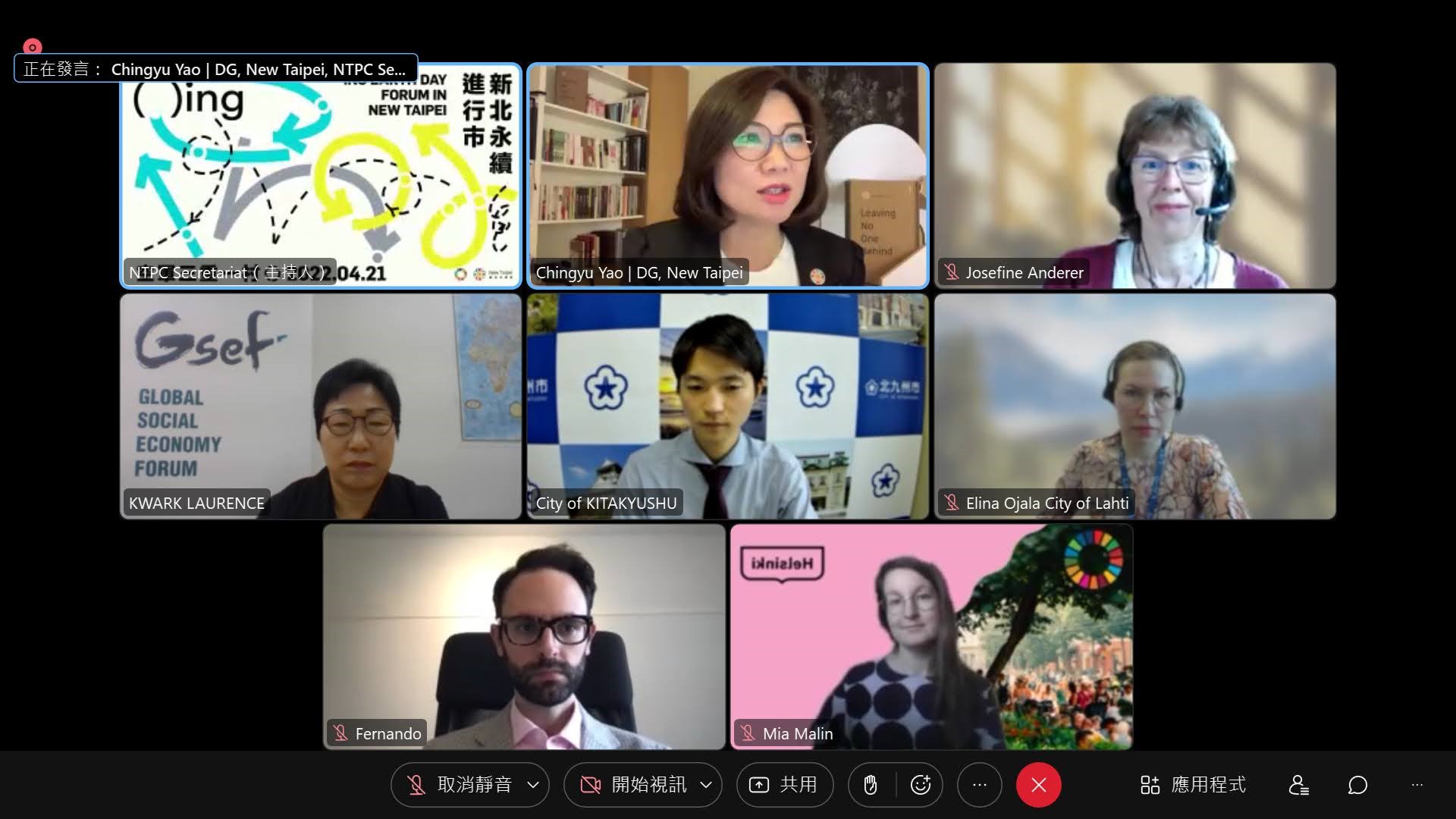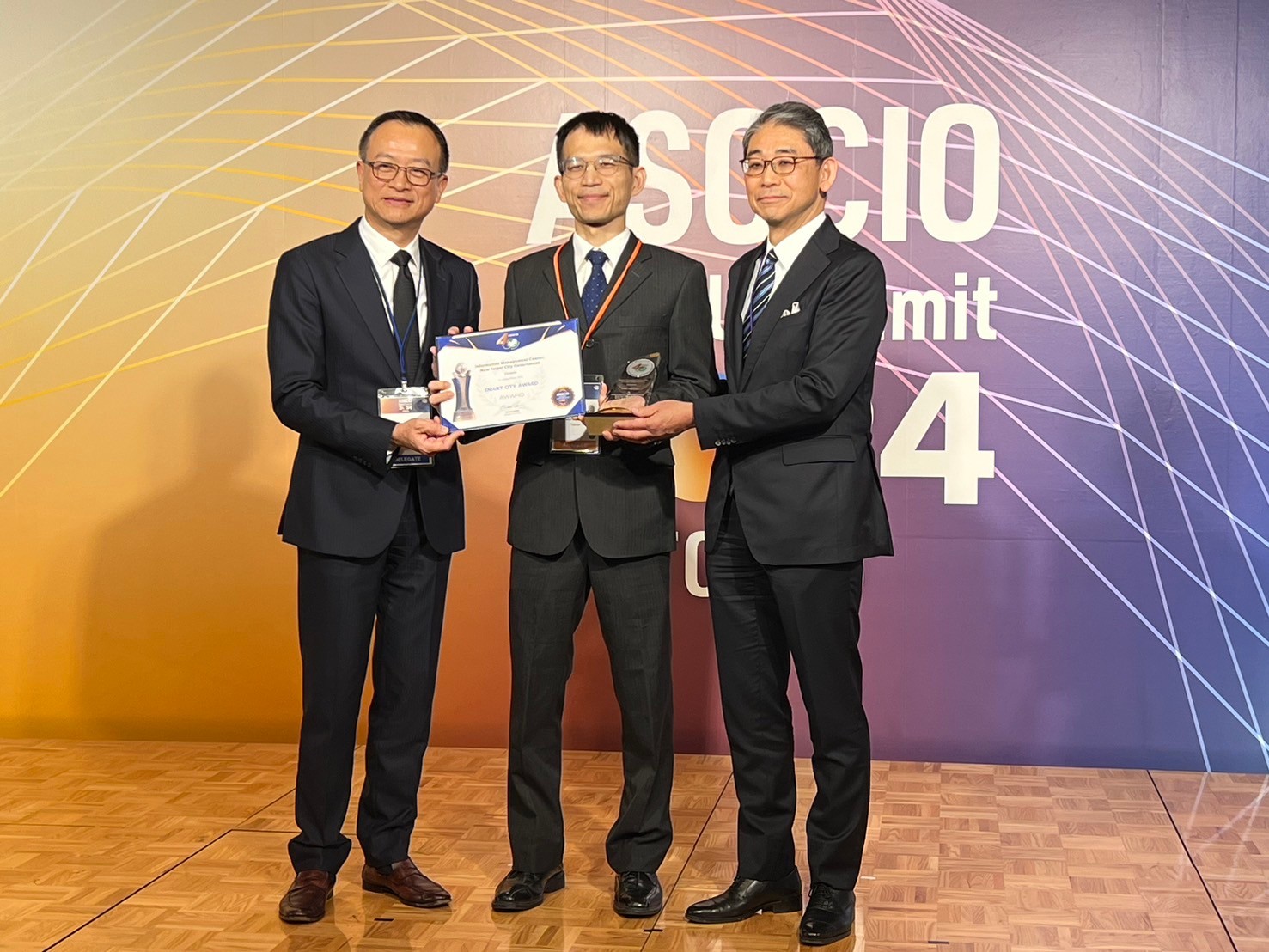【Events Highlights 05】SDG City Leaders Session: Helsinki, Lahti, Starnberg, Kitakyushu, IGES, and GSEF
2022-06-02

The "2022 ING Earth Day Forum in New Taipei" held by New Taipei City on April 21 focused on sustainable topics, including "low-carbon mobility" and "SDG City Leaders." More than 20 speakers attended the Forum online and offline globally from 4 states, 6 time-zones, 10 countries, and 15 cities as well as various international organizations, including the International Telecommunication Union (ITU), the United Cities and Local Governments Asia Pacific (UCLG ASPAC), Global Social Economy Forum (GSEF), Google, Mobility In Harmony (MIH), and Japanese think tanks. In this article, we would like to cover the remarkable exchanges in the "SDG City Leaders" session.
Ms. Mia Malin, Senior Advisor for Sustainability, City of Helsinki
Helsinki has been an early adopter of sustainability initiatives, with two VLRs published since 2019 and a website set up to facilitate cooperation with cities and the UN. Their main strategy is to engage citizens as key players, including encouraging citizens to take sustainable development as the part of life in the post-epidemic era.
Also, Helsinki has extended sustainability to urban renewal and business operations. Regarding the urban sustainability, they have established comparative indicators for more organizations to take part in. Helsinki also has budgeted to support different departments and companies in sustainable development. Aside from that, Helsinki provide sustainability training to raise awareness and understanding of this issue.
Also, Helsinki has extended sustainability to urban renewal and business operations. Regarding the urban sustainability, they have established comparative indicators for more organizations to take part in. Helsinki also has budgeted to support different departments and companies in sustainable development. Aside from that, Helsinki provide sustainability training to raise awareness and understanding of this issue.
Ms. Elina Ojala, Environmental Director, City of Lahti
Lahti has been certified as an EU Green Capital since 2021. Given that the industrial pollution was very serious back in the 98's, they have done a series of environmental protection campaigns, including lake decontamination and waste management systems. They want to be the first carbon neutral city in Finland by 2025. Lahti has a carbon reduction list, including stopping coal heating systems, reducing waste generation and landfill, and using green transportation.
In addition, Lahti has environmental educators to disseminate relevant concepts and brought citizen together from different fields developing policies and budgets to increase their participation. It is noteworthy that they launched an urban skiing campaign in 2021, where skis were available for rent and people could move around the city center on skis. Not only could it promote the concept of environmental sustainability but also be covered by the international media.
In addition, Lahti has environmental educators to disseminate relevant concepts and brought citizen together from different fields developing policies and budgets to increase their participation. It is noteworthy that they launched an urban skiing campaign in 2021, where skis were available for rent and people could move around the city center on skis. Not only could it promote the concept of environmental sustainability but also be covered by the international media.
Ms. Josefine Anderer, Climate Protection Manager, County of Starnberg
Starnberg started a fair trade certificate system in 2017 with the hope that there would be some specific targets. The government's specific measures include the procurement of Fair Trade compliant products. They currently have eight communities and 74% of the regions have received the Fair Trade Mark. They also have several educational programs, such as village outreach programs for elementary school students or developing internships or apprenticeships, to learn more about sustainable development. It is needed to understand that the environmental resources are not unlimited, so it's important to take them seriously.
Mr. Arima Kaito, Officer of Environment Bureau Kitakyushu Asian Center for Low Carbon Society, City of Kitakyushu
Kitakyushu City, a city with a long history of industrial development, had enjoyed the fruits of economic growth, but also had suffered unavoidable environmental pollution. The change of the city was first promoted by citizen groups. In the process it gradually cultivated a sense of unity among citizens, enterprises and the government. In 1997, Kitakyushu City built the Eco Town, which is the earliest recycling base and the largest garbage recycling park in Japan at present.
In addition, Kitakyushu is also the first city in Japan to promote pre-paid trash bag. In 2004, Kitakyushu formulated the Grand Design based on public opinions in hope of becoming the sustainable capital of the world. In 2017, Kitakyushu included SDGs in its urban development plan. In 2018, Kitakyushu was selected as a model city for promoting SDG by the OECD.
Moreover, Kitakyushu announced the goal of reducing greenhouse gas emissions by 47% by 2031 and revealed an ambitious vison : becoming a zero-carbon city by 2050. In 2022, Kitakyushu has formulated a green strategy for the growth of the industry. One of the specific goals is to use 100% renewable energy in the city. The city is currently promoting that all the electricity used by our indoor public facilities is supplied by renewable energy. Kitakyushu has cooperated with foreign cities since 1980. In 2010, the Asian Low-Carbon Center was established, and many projects have been implemented in cooperation with cities in Asia. The experience and ability accumulated in the past have been promoted to other countries.
In addition, Kitakyushu is also the first city in Japan to promote pre-paid trash bag. In 2004, Kitakyushu formulated the Grand Design based on public opinions in hope of becoming the sustainable capital of the world. In 2017, Kitakyushu included SDGs in its urban development plan. In 2018, Kitakyushu was selected as a model city for promoting SDG by the OECD.
Moreover, Kitakyushu announced the goal of reducing greenhouse gas emissions by 47% by 2031 and revealed an ambitious vison : becoming a zero-carbon city by 2050. In 2022, Kitakyushu has formulated a green strategy for the growth of the industry. One of the specific goals is to use 100% renewable energy in the city. The city is currently promoting that all the electricity used by our indoor public facilities is supplied by renewable energy. Kitakyushu has cooperated with foreign cities since 1980. In 2010, the Asian Low-Carbon Center was established, and many projects have been implemented in cooperation with cities in Asia. The experience and ability accumulated in the past have been promoted to other countries.
Dr. Fernando Ortiz-Moya, Policy Researcher, Institute for Global Environmental Strategies (IGES)
The sustainable development goals advocated by the United Nations include a total of 17 main goals and 169 specific goals. OECD mentioned that it requires the participation of local and regional governments to achieve 65% of the goals. The country cannot succeed alone. Therefore, a high-level political forum in New York proposed the idea of VLR. Since then, many local governments have begun to propose VLR to self-examine their efforts in promoting SDGs.
New Taipei City proposed VLR in 2019. In 2020, more local governments had published VLR. In 2021, including New Taipei City, a total of 46 cities in the world published VLR. Helsinki in Finland is also among them. Here are reasons we should keep promoting VLR. First of all, it encourages local governments to listen to the needs of the people and it reflects the people's voices in policy formulation. Secondly, VLR can also promote policy communication and coordination among various departments within the local government. Thirdly, through VLR, local governments can have a dialogue with global cities.
At present, there are also challenges in VLR, including the broad and complex issues involved in the SDGs. It is also not easy for the central and local governments to carry out vertical integration and the impact of the COVID-19 epidemic is not yet clear.
New Taipei City proposed VLR in 2019. In 2020, more local governments had published VLR. In 2021, including New Taipei City, a total of 46 cities in the world published VLR. Helsinki in Finland is also among them. Here are reasons we should keep promoting VLR. First of all, it encourages local governments to listen to the needs of the people and it reflects the people's voices in policy formulation. Secondly, VLR can also promote policy communication and coordination among various departments within the local government. Thirdly, through VLR, local governments can have a dialogue with global cities.
At present, there are also challenges in VLR, including the broad and complex issues involved in the SDGs. It is also not easy for the central and local governments to carry out vertical integration and the impact of the COVID-19 epidemic is not yet clear.
Ms. Laurence Kwark, Secretary General, Global Social Economy Forum (GSEF)
Established in 2014, GSEF cooperates with local governments to establish a sustainable ecosystem and together promote SSE, so that there have been an alternative way for economy and industry to grow, a way which is more sustainable.
The meaning of the term Social Solidarity Economy (SSE) covers knowledge, services and production. SSE can make society more united, equal and can also solve problems such as the gap between the rich and the poor, and at the same time promote the sustainability of social development.
Last year, the UN Secretary-General said in his report "Social transformational justice is to achieve sustainable development. SSE has played a very important role. It represents different models of growth. A new balance will be found in terms of efficiency and social environment." The EU also recognizes that SSE is very critical and important, and hopes that by promoting SSE, it can by 2030 achieve SDGs.
SSE has become more important during the pandemic. The pandemic has exposed the fragility of society and the failure of the modern economic system which has caused many inequalities and poverty in developing countries. Governments at all levels promote SSE in the hope of preventing the collapse of the economic system , resisting climate change and environmental over-exploitation.
During this year's ING Earth Day Forum, New Taipei City also invited speakers from Australia, the United States, Korea, and so on. To watch full speeches of other city leaders, please check out the video section on this website!
The meaning of the term Social Solidarity Economy (SSE) covers knowledge, services and production. SSE can make society more united, equal and can also solve problems such as the gap between the rich and the poor, and at the same time promote the sustainability of social development.
Last year, the UN Secretary-General said in his report "Social transformational justice is to achieve sustainable development. SSE has played a very important role. It represents different models of growth. A new balance will be found in terms of efficiency and social environment." The EU also recognizes that SSE is very critical and important, and hopes that by promoting SSE, it can by 2030 achieve SDGs.
SSE has become more important during the pandemic. The pandemic has exposed the fragility of society and the failure of the modern economic system which has caused many inequalities and poverty in developing countries. Governments at all levels promote SSE in the hope of preventing the collapse of the economic system , resisting climate change and environmental over-exploitation.
During this year's ING Earth Day Forum, New Taipei City also invited speakers from Australia, the United States, Korea, and so on. To watch full speeches of other city leaders, please check out the video section on this website!
Related Solutions
 Visitor:422
Visitor:422



